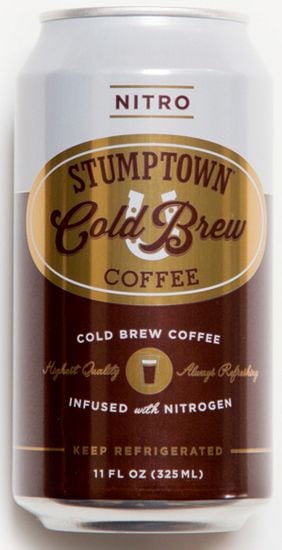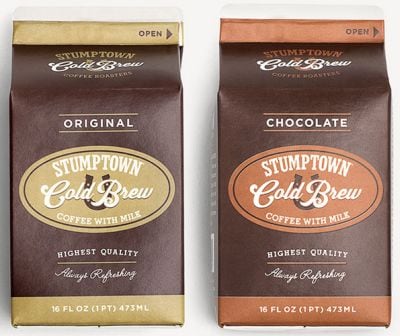The 14-year-old Portland, OR, coffee roaster and retailer is oft-credited with popularizing cold brew—which it began selling it in 10.5-ounce, ready-to-drink “stubby” bottles in 2011.
But the brew appeared to hit the mainstream this summer, as coffee chain Starbucks rolled out cold brew at 2,800 locations, Peet’s replaced all its iced coffee with cold brew, and Caribou added a permanent cold brew coffee beverage to its menu.
Commodity products go premium
Despite the hype, the cold brew process is nothing new. Whereas traditional iced coffee is made by cooling down hot-brewed coffee, cold brew is made by steeping coffee grounds in cool water for 12 to 24 hours and then filtering the resulting liquid for a smoother, less bitter brew.
“I think as with most products, it goes back to taste,” Stumptown cold brew director Diane Aylsworth said of cold brew’s growing momentum. “I still have conversations with people who say cold coffee is too bitter, so they’re aware of iced coffee’s bitter notes when it’s brewed hot and cooled down. The slow steeping of cold brew gives you a naturally sweet, easy-to-drink, low-acid coffee. As awareness grows, more people get the chance to taste it and have that ‘aha’ moment.”
It’s a good time for cold coffee in general. Last year, Americans consumed 90 million gallons of RTD coffee beverages, which encompasses everything from Starbucks Frappuccinos to Stumptown cold brew bottles, up 52% from 2009, according to Beverage Marketing Corp.
As awareness grows, more people get the chance to taste it and have that ‘aha’ moment
Drawing comparisons to beer and yogurt, Aylsworth said coffee is just one of countless examples of the growing movement toward more premium food and beverage products that focus on freshness and quality of ingredients.

“I think a lot of commodities go through this,” she said. “Yogurt used to be all about the flavors and mix-ins and tons of sugar. But then you get somebody producing high-quality yogurt, which allows you to enjoy the yogurt itself. It’s a similar play with specialty coffee. We’re all familiar with commodity coffee, trying to cover up the flavor with the roast, or cream or sugar. With more premium, specialty coffee, you experience the coffee itself, and use roasting and the brewing method to enhance that.”
The Guinness of cold brew coffee?
Stumptown has grown considerably since 2011, the year it also sold a majority stake to private-equity firm TSG Partners. (As of May 2015, TSG was rumored to be exploring a sale of that stake, according to the Wall Street Journal.)
The company has opened eight more cafes and two new roasting facilities, brought on ex-Jones Soda CEO Joth Ricci as president, expanded its wholesale business and grown its cold brew RTD line to include sweetened milk cartons and—earlier this year—nitrogenated cans.
Aylsworth wouldn’t disclose sales figures, though she said a notable slice of growth has come from natural and mainstream grocery channels, as more consumers are trading ready-to-drink coffee beverages for Stumptown’s cold brew. The brand only entered traditional supermarkets this year, after securing national distribution at Whole Foods. Aylsworth said she’s been surprised by the consistency of cold brew acceptance across regions.
When the can is cracked, the nitrogen is released in the form of tiny bubbles
Still, it’s hard to ignore the buzz surrounding one product in particular: nitro cold brew, Stumptown’s answer to canned Guinness. The company introduced a draught version its cafes in June 2013, which quickly caught on for its dramatic cascading effect when poured and creamy mouthfeel resulting from tiny nitrogen bubbles being forced into the brew under high pressure. Soon, Stumptown was shipping kegs of it to bars, cafes and offices nationwide.
To the delight of coffee nerds everywhere, the canned version debuted this past April. The cold brew is infused with nitrogen under pressure and poured into special aluminum cans with nitro widgets shipped from the Ball cannery in the UK. The brew is doused with nitrogen, which is captured and turned to gas by the widget, holding in the pressure until it’s opened.
“When the can is cracked, the nitrogen is released in the form of tiny bubbles—emulating pulling a draught handle—which creates that beautiful cascade effect when poured and creamy mouthfeel when you drink it,” Aylsworth said.
We have a unique ability to have a pulse on the industry across various channels
The cans launched in test markets in Southern California Whole Foods and New Seasons in Oregon and have flown off shelves, thanks in part to buzz generated by early coverage in Esquire and Bon Appetit magazines and on the “Today” show. Stumptown aims to broaden distribution in October or November, Aylsworth noted.

Part of the brand’s success has come from its ability to quickly test new products in its cafes before rolling them out at retail, Aylsworth said, adding that the cafes have acted as focus groups for everything from nitro brew to the seasonal cold brew with milk, which Stumptown launched in grocery stores this year.
“With our cafes and wholesale partners, we have a unique ability to have a pulse on the industry across various channels,” she said. “In general, the opportunity to be able to talk to customers face to face every day is one you’d wish for in a CPG and so rarely have.”
Maintaining quality (and chilliness)
The biggest challenge of scaling any of Stumptown’s RTD cold brews, Aylsworth said, is their short shelf life. A low-acid product, the cold brew is kept food-safe through a fully chilled distribution network.
“Typical beverage distribution networks are ambient,” Aylsworth said. “We’ve been piecing it together through traditional grocery distributors as well as natural like (United Natural Foods Inc.), and we’re also working with local distributors that can handle the product cold and reach our independent cafes and small wholesale partners.”
Chilled distribution also preserves the freshness and flavor of the brew, which would be destroyed with the application of heat and effectively undo what Stumptown has grown on.
“Delivering something low acid that’s ambient, we’d have to acidify it or apply high-temperature pasteurization, so we’d then have to cover up those off flavors with cream or sugar. To me, the beauty of cold brew is it’s this delicious-tasting black coffee and there’s nothing else like it on market. We have to preserve that.”
